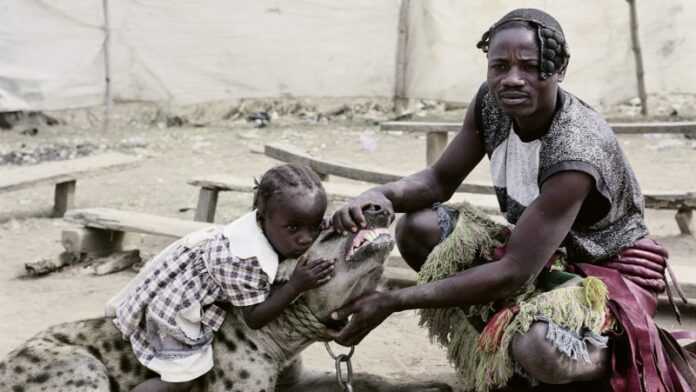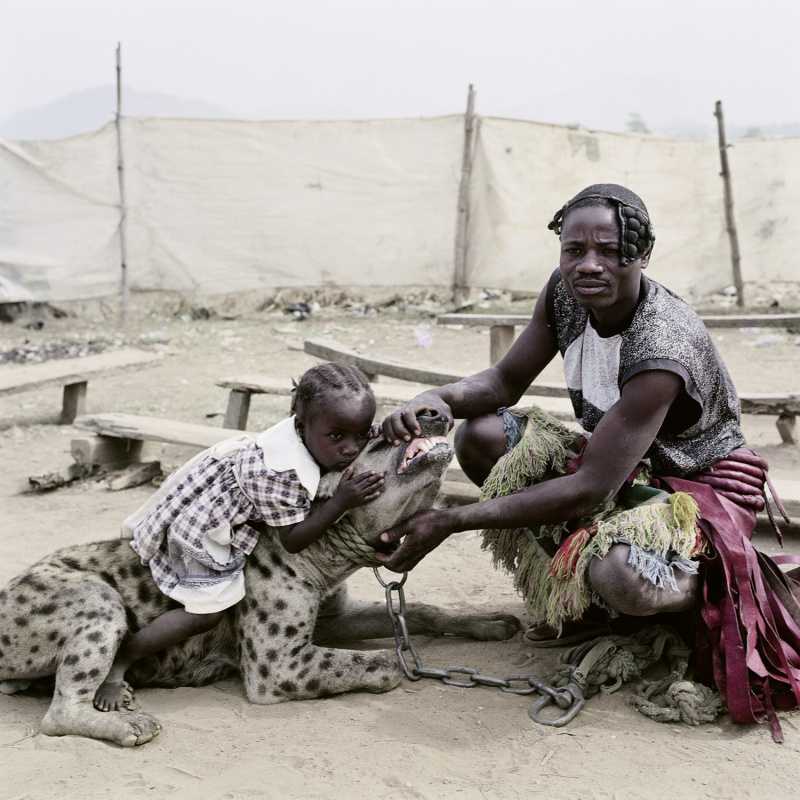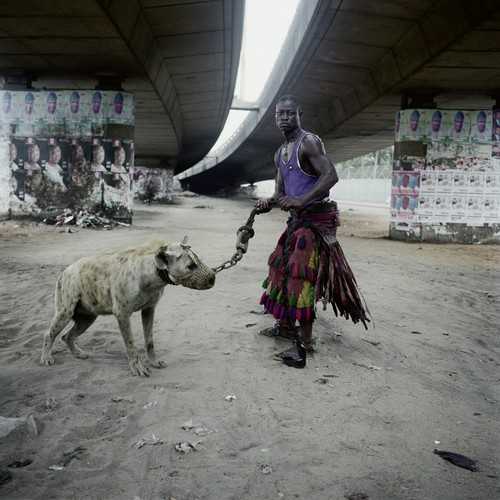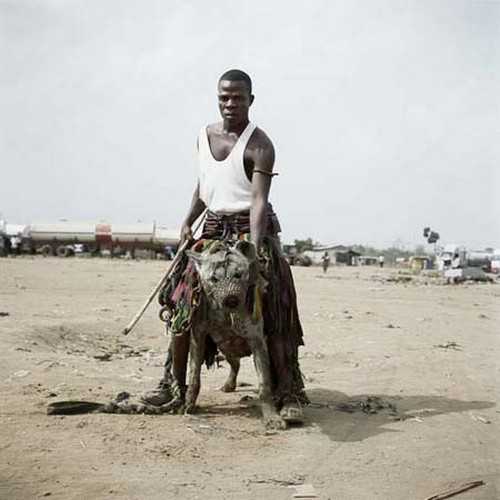
South African photographer Pieter Hugo has immortalized a troop of hyena handlers in Nigeria in his series “The Hyena and Other Men”. The group, composed of seven men, has an even more unusual side attraction: A 6 year old girl who rides the hyenas as if they were ponies. Pieter Hugo’s photographs expose the myth of the “Gadawan Kura”, as they are called in Hausa.
It is a spectacular scene, almost like Alice in wonderland. A group of men stroll nonchalantly down the streets of a Nigerian city accompanied by their pet hyenas and a 6 year old girl delicately riding on the back of one of the frightful beasts. Amazed by the spectacle, a Nigerian friend of South African photographer Pieter Hugo sends him pictures of the men and their beasts in 2005.
Awed, the artist digs for more information about the group and learns that they have been accused by the Nigerian media of bank robberies, drug deals or even used by loan sharks to terrorize defaulting debtors. Pieter Hugo decides to travel to Nigeria to meet the “Gadawan Kura”, the Hausa name for hyena handlers.
His trip to Nigeria marks the beginning of “The Hyena and Other Men” series, which he finishes in 2007. Instead of thugs, he encounters a group of street performers who earn their living by exhibiting their hyenas, baboons, pythons and other wild animals. The photographer blends into the group of men, who belong to the same, but extended, family. All of them handlers, from father to son, and accompanied by the six year old girl who mounts the scavenging beasts without fear.
 The members of the troupe have scars and wounds on their faces, legs and hands; a constant reminder of the savagery of the animals. The “Gadawan Kura” always carry a stick to defend themselves and subdue the animals when needed. But according to Abdullahi Ahmadu, ‘Mummy’ his six-year-old daughter “cannot be harmed. It’s the same thing with the snakes and monkeys. She has taken a potion of traditional herbs and has been bathed with it. So her safety from the animals is guaranteed for the rest of her life.”
The members of the troupe have scars and wounds on their faces, legs and hands; a constant reminder of the savagery of the animals. The “Gadawan Kura” always carry a stick to defend themselves and subdue the animals when needed. But according to Abdullahi Ahmadu, ‘Mummy’ his six-year-old daughter “cannot be harmed. It’s the same thing with the snakes and monkeys. She has taken a potion of traditional herbs and has been bathed with it. So her safety from the animals is guaranteed for the rest of her life.”
Before catching their wild animals, the trainers bathe in potions and tie amulets around their ankles while chanting incantations to protect themselves from the dangerous animals. The men believe they become invincible to the wild animals during their expeditions after administering the necessary voodoo charms. Ahmadu explains that, the beast, which is initially not accustomed to humans, puts up a fight until a potion is smeared on its body, after which it immediately becomes obedient.
Business
It is a business that has been in the family since Abdulahi’s childhood. Apart from the generosity of their onlookers during the street performances given by their trained animals, the handlers also take the opportunity of the huge crowds they pull to sell traditional herbs, concoctions, powders and other voodoo objects. They also sell talismans to ward off the evil eye.
 Yahaya, one of the handlers, says they have taken part in films and sometimes provided film producers with wild animals. They have furnished Zoos from countries in the sub-region with wild animals. “A mature hyena is sold for one hundred and fifty thousand naira, but a cub is more expensive at two hundred and fifty thousand naira. This is because a cub can be trained. An adult baboon goes for fifteen thousand naira, a young one for eight thousand. A python goes for eight to ten, depending on the size.”
Yahaya, one of the handlers, says they have taken part in films and sometimes provided film producers with wild animals. They have furnished Zoos from countries in the sub-region with wild animals. “A mature hyena is sold for one hundred and fifty thousand naira, but a cub is more expensive at two hundred and fifty thousand naira. This is because a cub can be trained. An adult baboon goes for fifteen thousand naira, a young one for eight thousand. A python goes for eight to ten, depending on the size.”
Although, the Hyena men are duly licensed to operate in several Nigerian states, not everyone accepts their trade. And the hyena men have rejected as false the stories of armed banditry that were read by Pieter Hugo before his trip to meet them. In 2004, the Nigerian media had run stories about an armed robbery that left two policemen dead and a hyena and a monkey shot.
But the men, supported by the driver, Lekan Fabuyi, who was carrying them at the time, give a different account of what took place. “We refused to stop at a police checkpoint, so the police opened fire on us, killing two hyenas and two fellow policemen. To protect themselves, they fixed a charge of armed robbery on us. Thank God, the case has died a natural death,” says Abdullahi Ahmadu.
“They eat by taking these animals around. Stop them and they take to criminality. Those criticising cannot give them another job,” Lekan Fabuyi says in their defense.
Hybridisation of urban and wild
During his first trip in 2005, Pieter Hugo caught, not only the performers on film, but also the crowds of curious onlookers who surrounded them as well as the ensuing traffic jams. Initially, Pieter told himself that the photographs held little interest after failing to capture the overwhelming spectacle of the group walking down busy market streets.
 “I realised that what I found fascinating was the hybridisation of the urban and the wild, and the paradoxical relationship that the handlers have with their animals – sometimes doting and affectionate, sometimes brutal and cruel.”
“I realised that what I found fascinating was the hybridisation of the urban and the wild, and the paradoxical relationship that the handlers have with their animals – sometimes doting and affectionate, sometimes brutal and cruel.”
In 2007, the photographer decided to concentrate on portraits and “started looking for situations where these contrasting elements became apparent”, capturing the hyena handlers in deserted urban areas such as underneath bridges or on wastelands.
Every photograph caption has the name of the depicted animal: Abdullahi Mohammed with Mainasara or Galadima Mallam Ahmadu with Jamis, for example. Double portraits that highlight the relationship between handler and handled; a mix of fear and mutual respect.

